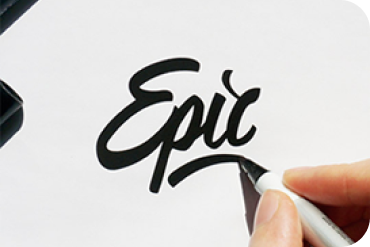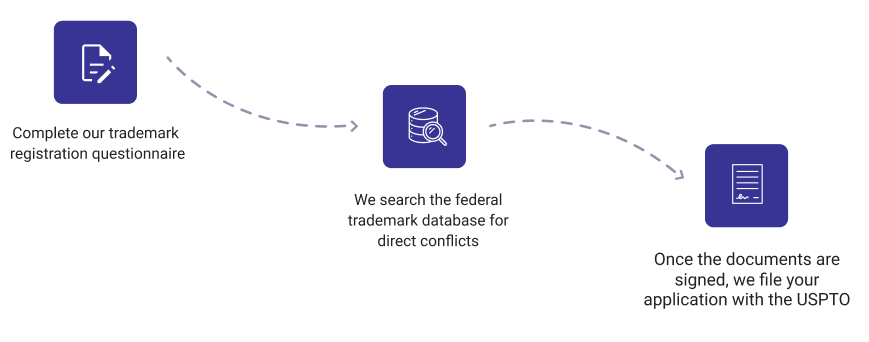Process of obtaining a trademark

What is the process of obtaining a trademark?
The process can be simplified into the following steps
1. Search
Conduct a trademark search to ensure an identical or confusingly similar mark is not already registered for the same class of goods or services as yours. If the mark is already registered, it will be rejected, at which point you will most likely need an attorney to help proceed.
2. Information
Collect all necessary information such as any drawings of the trademark and the date of first use.
3. Completion
Conduct a trademark search to ensure an identical or confusingly similar mark is not already registered for the same class of goods or services as yours. If the mark is already registered, it will be rejected, at which point you will most likely need an attorney to help proceed.
4. File Application
File the application with the U.S. Patent and Trademark Office (USPTO) and pay the fees depending on the type and number of classes you are registering.
5. Respond
If issued an office action, respond promptly. Modify your application based on the office action and re-submit. Some office actions are very complex and require the help of a trademark specialist.
Work with a trademark attorney from determining the legal strength of your mark to responding to office actions and filing declaration five to ten years down the line. Our experts are ready to help you ensure your mark‘s protection.
How do you file a trademark, and what information
do you need to fill out the application?

Collect all the information you need

Valid mark or logo
A strong, distinctive and registrable mark is needed. A unique and distinctive mark for your class of goods or services being offered, such as Google or Nike, is legally stronger. A mark does not qualify for registration if it is a generic term of the goods or service. However, if the descriptive mark acquires secondary meaning, it may be eligible for registration. Our skilled trademark attorneys can assist you in determining the strength of your mark and how to make it stronger to further bulletproof your application.
Drawing of the mark:
A clear drawing or depiction of the trademark is required. For word marks, write out the word. For drawings, attach a photo file.


Date of first use
The date you first used your mark in commerce to identify your company as the source of the goods and/or services you provide.
Class of Goods & Services
Classes are different categories of goods or services organized by the USPTO. There are 45 classes. When registering your mark, you must identify which class you wish to register your mark for. If you are registering for more than one class, additional fees are required for each.


Complete the Application – online

Collect all the information you need

Valid mark or logo
A strong, distinctive and registrable mark is needed. A unique and distinctive mark for your class of goods or services being offered, such as Google or Nike, is legally stronger. A mark does not qualify for registration if it is a generic term of the goods or service. However, if the descriptive mark acquires secondary meaning, it may be eligible for registration. Our skilled trademark attorneys can assist you in determining the strength of your mark and how to make it stronger to further bulletproof your application.
Drawing of the mark:
A clear drawing or depiction of the trademark is required. For word marks, write out the word. For drawings, attach a photo file.


Date of first use
The date you first used your mark in commerce to identify your company as the source of the goods and/or services you provide.
Class of Goods & Services
Classes are different categories of goods or services organized by the USPTO. There are 45 classes. When registering your mark, you must identify which class you wish to register your mark for. If you are registering for more than one class, additional fees are required for each.


Complete the Application – online

FAQs
What is a trademark and what can you trademark?
A trademark identifies and distinguishes the source of the goods or services of one party from those of others. A trademark may be a word, phrase, symbol, design, or a combination thereof. Some examples include brand names, slogans, and logos.
How do trademarks, copyrights, and patents differ?
Trademarks, copyrights, and patents protect different types of intellectual property. A trademark typically protects brand names and logos used on goods or services. A copyright protects an original artistic or literary work. A patent protects an invention.
Unlike patents and copyrights, trademarks do not expire after a set term of years. A trademark can last forever so long as you continue to use the mark in commerce to indicate the source of goods and services. Trademark registration can also last forever so long as you file specific documents and pay fees at regular intervals.
How do trademarks, domain names, and business names differ?
Trademark law is designed to enable consumers to identify and distinguish goods or services from a particular source.
A domain name is part of a web address that links to the Internet Protocol address (IP address) of a particular website. You register your domain name with an accredited domain name registrar, which does not confer any trademark rights.
A business name is registered in a state or local jurisdiction as part of forming a business entity (e.g., a corporation or limited liability company). For example, you select ABC, Inc. as the name for your company. If no other company has already occupied that exact name in that state and you comply with all other requirements, the state likely will authorize you to do business under that name. However, it does not give you trademark rights; other parties could later try to prevent your use of the business name if they believe a likelihood of confusion exists with their trademarks.
Is registration of my mark guaranteed?
No. The examining attorney will review the application and may issue refusals. The most common reason to refuse registration is a “likelihood of confusion” between the mark of the applicant and a mark already registered or in a prior-filed pending application owned by another party. Principal factors in determining a likelihood of confusion exists are: (1) the marks are similar, and (2) the goods and services of the parties are related such that consumers would mistakenly believe they come from the same source.
In addition, the USPTO will refuse the registration for many other reasons, including if the mark is:
- Merely descriptive of the goods and services;
- A surname;
- Solely ornamental as applied to the goods;
- Primarily geographically descriptive or deceptive; and
- A foreign term that translates to a descriptive or generic term.
When can I use the trademark symbols TM, SM, and ®?
If not yet registered, you may use “TM” (trademark) or “SM” (service mark) regardless of whether you have filed an application with the USPTO. Those symbols put the public on notice that you claim rights in the mark, although common law does not give you all the rights and benefits of federal registration.
You may only use the federal registration symbol “®” after the USPTO registers a mark, not while an application is pending. “®” may only be used on or in connection with the goods and services listed in the federal trademark registration and while the registration is still alive. It puts the public on notice that your mark is registered and that you have nationwide rights in it. There are no specific requirements on where the symbol should be placed relative to the mark, but most businesses use the symbol in the upper right corner of the mark.
How long does a trademark registration last?
The registration is valid as long as you timely file all post-registration maintenance documents. You should file a “Declaration of Use under Section 8” between the fifth and sixth year following registration. In addition, you should file a combined “Declaration of Use and Application for Renewal under Sections 8 and 9” between the ninth and tenth year after registration, and every 10 years thereafter. If these documents are not filed in a timely manner, your registration will be canceled and cannot be revived or reinstated.
